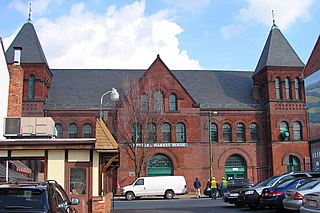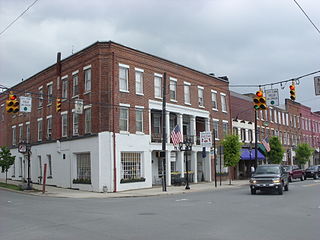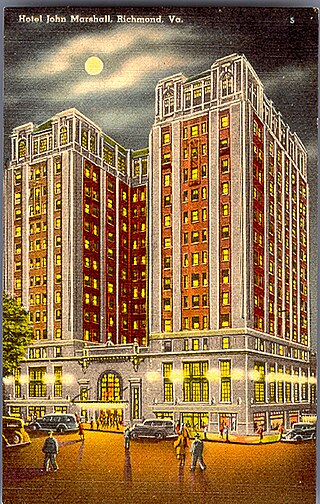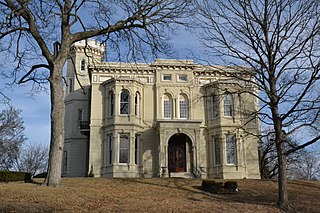
The Quaker Hill Historic District is a national historic district located at Wilmington, New Castle County, Delaware. It encompasses 151 contributing buildings in a residential neighborhood west of the central business district of Wilmington. The district includes 19th-century residential structures of all classes, along with several 19th-and 20th-century commercial structures. The predominant structures are three-story rowhouse dwellings in a variety of popular styles including Second Empire, Italianate, and Gothic Revival. Notable non-residential buildings include the Quaker Meetinghouse and Cemetery, St. Peter's Cathedral and Rectory (1816), Union Methodist Church, and New Mount Bethel Baptist Church

Downtown Altoona Historic District is a national historic district located at Altoona, Blair County, Pennsylvania. The district includes 240 contributing buildings in the central business district and surrounding residential areas of Altoona. The buildings were primarily built after about 1860 and include residential, civic, social, and religious buildings. Although it does not encompass the entire downtown, it is for the most part the most urban part of Altoona's downtown district. Notable buildings include the Cathedral of the Blessed Sacrament (1920s), First Methodist Episcopal Church, First Presbyterian Church, First Evangelical Lutheran Church (1896-1897), U.S. Post Office (1931-1933), Fraternal Order of Eagles Building (demolished), Altoona City Hall, Casanave Building (1890s), Hutchison Block, McCrory's Department Store (1937), and Aaron-Penn Furniture Building. Located in the district are the separately listed Central Trust Company Buildings, Mishler Theatre, and Penn Alto Hotel.

The Moxham Historic District is a national historic district that is located in Johnstown in Cambria County, Pennsylvania.

The York Historic District is a national historic district that is located in the central business district and surrounding residential areas of York in York County, Pennsylvania. It is situated north of the Springdale Historic District.

The Mercersburg Historic District is a national historic district that is centered on the center square of Mercersburg in Franklin County, Pennsylvania.

The Lancaster Historic District, also known as Old Town Lancaster, is a national historic district that is located in Lancaster, Lancaster County, Pennsylvania.

The High Street Historic District is a national historic district which is located in Pottstown, Montgomery County, Pennsylvania.

The Milton Historic District is a national historic district that is located in Milton, Northumberland County, Pennsylvania.

The Tamaqua Historic District is a national historic district that is located in Schuylkill Township and Tamaqua, Schuylkill County, Pennsylvania.

The Ligonier Historic District is a national historic district that is located in Ligonier, Westmoreland County, Pennsylvania.

The Mount Pleasant Historic District is a national historic district that is located in Mount Pleasant, Westmoreland County, Pennsylvania.

The Tunkhannock Historic District is a national historic district that is located in Tunkhannock, Wyoming County, Pennsylvania.

The North East Historic District is a national historic district that is located in North East, Erie County, Pennsylvania.

The Titusville Historic District is a national historic district that is located in Titusville, Crawford County, Pennsylvania.

Marion Historic District is a national historic district located at Marion, Smyth County, Virginia. The district includes 361 contributing buildings, 2 contributing sites, and 1 contributing object in the central business district and surrounding residential areas of Marion. It includes a variety of residential, commercial, institutional, industrial, and governmental buildings primarily dating from the mid-19th to mid-20th centuries. Notable buildings include the Sheffey Loom House, Odd Fellows Lodge, Look & Lincoln Wagon Factory warehouse, the Beaux-Arts style Marion County Courthouse (1905), Mt. Pleasant Methodist Church, Courtview Building (1890s), Marion High School (1907-1908), Marion Junior College (1912), the Overall Factory, Weiler Building, Bank of Marion (1922), Royal Oak Presbyterian Church (1923), Marion Municipal Building (1935), Marion Post Office (1936), and a Lustron house (1948). Also located in the district are the separately listed Hotel Lincoln, Lincoln Theatre, Marion Male Academy, and Norfolk & Western Railway Depot.

The Grace Street Commercial Historic District is a national historic district located in Richmond, Virginia. The district encompasses 93 contributing buildings located in downtown Richmond. The buildings reflect the core of the city's early 20th-century retail development and the remnants of a 19th-century residential neighborhood. The buildings are in a variety of popular 19th-century and early 20th-century architectural styles, including Classical Revival, Mission Revival, International Style, and Colonial Revival. Notable buildings include the Administration and Equipment Building for the Chesapeake & Potomac Telephone Company (1929), Thalhimer's Department Store, Atlantic Life Building (1950-1959), Miller & Rhoads Department Store, Berry-Burk Building, former W. W. Foster Studios (1927), Bank of Virginia (1949), Investment Realty Company building (1930), W.T. Grant Store (1939), Hotel John Marshall (1927), Franklin Federal Savings and Loan building (1954), and the Tompkins House (1820). Located in the district and separately listed are the Loew's Theatre, Centenary United Methodist Church, Joseph P. Winston House, Central National Bank, and National Theater.

Suffolk Historic District is a national historic district located at Suffolk, Virginia. The district encompasses 514 contributing buildings, 3 contributing structures, and 3 contributing objects in Suffolk. The district includes a variety of residential, commercial, governmental, and institutional buildings. They are in a variety of vernacular and popular 19th and 20th century architectural styles including Greek Revival, Queen Anne, and Bungalow. Notable buildings include the Allmond Building (1914), Macedonia A.M.E. Church, National Bank of Suffolk (1914-1920), the Old Post Office, old Nansemond County Courthouse, John Granberry house, Richard Seth Eley House (1878), Jones Building, Suffolk Towers, Virginia Apartments (1918-1920), Causey-Kendrick house (1882), Masonic Hall (1911), Suffolk High School (1922), Jefferson High School (1911), old Methodist Church (1861), St. Paul's Episcopal Church (1895), Suffolk Christian Church (1893), and Congregation of Agudath Achin. Located in the district are the separately listed Phoenix Bank of Nansemond, Professional Building, and Riddick House.

West End Historic District is a national historic district located at Suffolk, Virginia. The district encompasses 201 contributing buildings and 93 contributing structures in a primarily residential section of the city of Suffolk. The district includes buildings dating from the last decade of the 19th century through the first four decades of the 20th century in a variety of popular architectural styles including Queen Anne and Folk Victorian. The residences were developed to support the growing upper-, middle-, and working-class populations. Notable buildings include the J. C. Causey, Jr. House, Oxford United Methodist Church (1922), and West End Baptist Church (1938).
Snow Hill Historic District is a national historic district located at Snow Hill, Greene County, North Carolina. The district encompasses 229 contributing buildings, a contributing site, two contributing structures, and a contributing object in the central business district and surrounding residential sections of Snow Hill. The buildings are in a variety of popular 19th and early-20th century architectural styles including Greek Revival, Gothic Revival, Colonial Revival, and, Bungalow / American Craftsman. Located in the district are the separately listed Greene County Courthouse and St. Barnabas Episcopal Church. Other notable buildings include J. Exum & Co. Grocery building, Harper Drugstore, Sugg-Harper House, Williams-Exum Housem, Murphrey-Morrill House (1885), Josiah Exum House (1887-1888), Alfred Warren House (1912-1915), Calvary Memorial Methodist Church (1928), Snow Hill Presbyterian Church (1935), and former First Baptist Church.

Museum Hill Historic District is a national historic district located at St. Joseph, Missouri. The district encompasses 248 contributing buildings in a predominantly residential section of St. Joseph. It developed between about 1860 and 1942, and includes representative examples of Italianate, Second Empire, Queen Anne, Tudor Revival, American Foursquare, and Bungalow / American Craftsman style architecture. Located in the district is the separately listed Robidoux School. Other notable buildings include the First Congregational Church (1890), Francis Street Methodist Church (1905), First Baptist Church (1896) designed by architect Edmond Jacques Eckel (1845–1934), United Presbyterian Church (1901), First Church of Christ Scientist (1905), First English Evangelical Lutheran Church (1913), and Queen of the Apostles Roman Catholic Church (1908) designed by Eckel.























